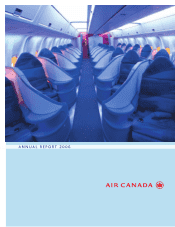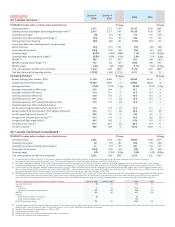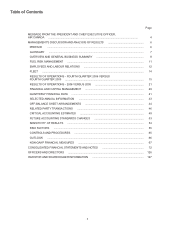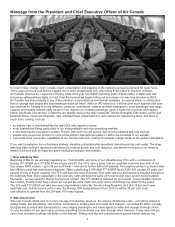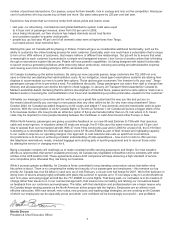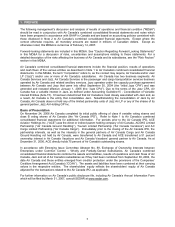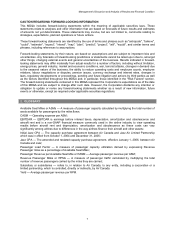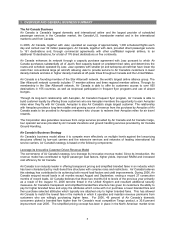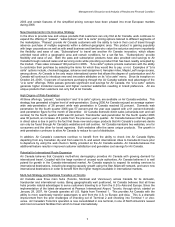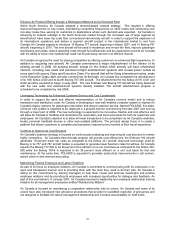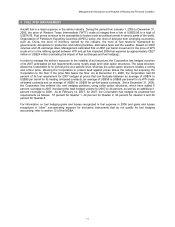Air Canada 2006 Annual Report Download - page 8
Download and view the complete annual report
Please find page 8 of the 2006 Air Canada annual report below. You can navigate through the pages in the report by either clicking on the pages listed below, or by using the keyword search tool below to find specific information within the annual report.
3. OVERVIEW AND GENERAL BUSINESS SUMMARY
The Air Canada Business
Air Canada is Canada's largest domestic and international airline and the largest provider of scheduled
passenger services in the Canadian market, the Canada-U.S. transborder market and in the international
market to and from Canada.
In 2006, Air Canada, together with Jazz, operated an average of approximately 1,300 scheduled flights each
day and carried over 32 million passengers. Air Canada, together with Jazz, provided direct passenger service
to 161 destinations and, through commercial agreements with other unaffiliated regional airlines, to an
additional 15 destinations, for a total of 176 direct destinations on five continents.
Air Canada enhances its network through a capacity purchase agreement with Jazz pursuant to which Air
Canada purchases substantially all of Jazz's fleet capacity based on predetermined rates and determines the
routes and schedule operated by Jazz. Jazz operates with smaller jet and turboprop aircraft that have lower trip
costs than conventional large jet aircraft, allowing Jazz to provide service to Air Canada's customers in lower
density markets and also in higher density markets at off-peak times throughout Canada and the United States.
Air Canada is a founding member of the Star Alliance® network, the world's largest airline alliance group. The
Star Alliance® network currently includes 17 member airlines and three regional member airlines. Through its
membership in the Star Alliance® network, Air Canada is able to offer its customers access to over 855
destinations in 155 countries, as well as reciprocal participation in frequent flyer programs and use of airport
lounges.
Through its long-term relationship with Aeroplan, Air Canada's frequent flyer program, Air Canada is able to
build customer loyalty by offering those customers who are Aeroplan members the opportunity to earn Aeroplan
miles when they fly with Air Canada. Aeroplan is also Air Canada's single largest customer. The relationship
with Aeroplan provides a long-term stable and growing source of revenue from the purchase by Aeroplan of Air
Canada seats to be provided to Aeroplan members who choose to redeem their Aeroplan miles for air travel
rewards.
The Corporation also generates revenues from cargo services provided by Air Canada and Air Canada Cargo,
tour operator services provided by Air Canada Vacations and ground handling services provided by Air Canada
Ground Handling.
Air Canada’s Business Strategy
Air Canada’s business model allows it to compete more effectively on multiple levels against the low-pricing
structures offered by low-cost carriers and the extensive services and networks of leading international full
service carriers. Air Canada's strategy is based on the following components:
Leverage its Innovative Customer Driven Revenue Model
The cornerstone of Air Canada's strategy is to leverage its innovative revenue model. Since its introduction, the
revenue model has contributed to higher passenger load factors, higher yields, improved RASM and increased
cost efficiency for Air Canada.
Air Canada is an industry leader in offering transparent pricing and simplified branded fares in an industry which
has been characterized by multi-tiered fare structures with complex rules and restrictions. Air Canada believes
this strategy has contributed to its achieving both record load factors and yield improvements. During 2006, Air
Canada enjoyed record loads in all months except August and September, ending a record 27 consecutive
months of record loads. Air Canada believes that these two months fell to levels of the previous year primarily
as a result of the August 10, 2006 terrorist threat in the United Kingdom and resultant additional security
measures. Air Canada’s transparent and simplified branded fare structure has given its customers the ability to
pay for higher branded fares and enjoy the attributes which come with it or purchase a lower branded fare and
then purchase selected attributes which typically are attached only to higher branded fares. This has allowed
Air Canada to match the lowest fare in the markets in which it operates and maintain revenue premiums from
customers who are willingly purchasing higher fares. For 2006, 46 percent of Air Canada’s domestic
consumers picked a branded fare higher than Air Canada’s most competitive Tango product, a 30.6 percent
improvement over 2005. The simplified pricing concept has been in place in the North American market since
8

